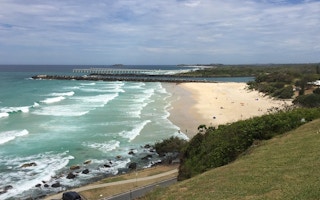Right now, around a third of the world’s coastline is made up of sandy beaches and dunes which slope gently and softly to the sea. By the end of the century, these could make up only one-sixth of the frontier between land and ocean. Sea level rise driven by global heating could sweep half of them away.
Beaches are nature’s buffers between eroding land and tempestuous sea: they protect the coast, they provide a unique habitat for wildlife, and they have become powerful socio-economic resources.
But the paradise for surfers around sunlit Australia is almost certain to be diminished in the coming climate crisis as the waves lap ever higher, storm surges sweep away vast volumes of sand, and seas flood low-lying coasts. And – according to new European research in the journal Nature Climate Change – what is true for Australia is true for much of the rest of the world.
How much beach is lost will depend on how nations respond to the challenge of climate change. But in the worst-case scenario, Australia and Canada could each say goodbye to nearly 15,000 kilometres of sandy shore by 2100. Chile could lose more than 6,000 km, Mexico, China and the US more than 5,000 km, Russia more than 4,000 km and Argentina more than 3,000 km.
“
Much of the world’s coast is already eroding, which could get worse with sea level rise.
Sally Brown, deputy head of Department of Life and Environmental Sciences, Bournemouth University
And that’s the outlook for countries with vast coastlines. Some could fare even worse. Guinea-Bissau and The Gambia in West Africa, for instance, could lose 60 per cent of their beaches.
The European scientists looked at more than 30 years of satellite data on coastal change – from 1984 to 2015 – and 82 years of climate and sea level predictions from a range of climate models. They also simulated 100 million storm events.
There is plenty of evidence that the world’s seas are responding to climate change; that sea levels are rising in response to warmer atmospheric temperatures driven by profligate combustion of fossil fuels; and that coastal flooding is likely to become more extreme.
But the detailed questions remain: how exactly will ever-higher tides exact their toll of the wetlands, mangrove forests, estuaries, cliff faces, rocky coasts, storm beaches and dunes that serve as a barrier between the maritime cities and towns of the world, and the saltwater? The researchers found that even in the more hopeful scenarios, there would be considerable losses.
UK backs study
But if nations delivered on the promise made in Paris in 2015 – a promise that still has to be backed up by urgent action on a global scale – to contain global heating to “well below” a maximum of 2°C by 2100, then perhaps 40 per cent of the projected erosion of beaches could be halted.
Beaches are natural features of tidal landscapes: sand swept away by violent storms is eventually replaced by silt carried down the rivers to the coasts. The shoreline has always changed. But change is accelerating. Scientists in the UK have endorsed the European study.
“Much of the world’s coast is already eroding, which could get worse with sea level rise,” said Sally Brown, of Bournemouth University. Bournemouth is a famous British seaside resort.
“Building defences helps maintain coastline position, but defences are known to reduce beach width or depth over multiple decades. Responding to sea level rise means looking strategically at how and where we defend coasts today, which may mean protecting only limited parts of the coast.”
This story was published with permission from Climate News Network.








